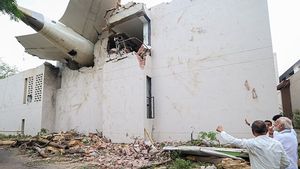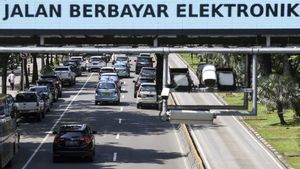JAKARTA - Talking about areas that have never been absent from floods, it is certainly not complete without including the name of the city (which currently still has the status of the capital city of Indonesia), Jakarta. Apart from being known as a metropolitan city which is now developing without control, Jakarta is also chaotic in transforming water catchment areas into infrastructure projects.
At least, that is the reality that is developing today. However, if you drag it to some time ago. The "flood" narrative has even reached Jakarta, which Bung Karno called the lighthouse where the struggle of all mankind.
This happened long before the big floods in 2002, 2007, 2013, until the latest (to coincide with welcoming the new year) 2020. The impact of course inundated 12 large roads and submerged many houses in Jakarta. Even claiming casualties in a number of locations.
However, before that the phenomenon of flooding had started to become a problem with the capital's power holders. In fact, before the capital was named Jakarta.
Because since it was named Batavia, both when the center of government was still in Oud Batavia (Old Batavia: Kota Tua Area) until it was moved by Herman Willem Daendels, Governor General of the Dutch East Indies (1808-1811), from the coast to Nieuw Batavia (New Batavia: the surrounding area Banteng Field now) flood is always a problem during the rainy season.

To the extent that Susan Blackburn in her book entitled "Jakarta's History of 400 Years," revealed that (at that time) for most Europeans, Batavia was an uninhabitable place because in the dry season the canals gave off a bad smell, and in the rainy season it was inviting. flood.
He said: “The tide brings sand which blocks the flow of river water, and more and more mud is carried downstream due to land clearing in the upstream area for agriculture. The combination of all these things causes flooding. "
Indeed, the floods in Jakarta resemble the Jakarta Fair celebration (which is always held every year). Due to frequent floods, Jakarta residents have the opinion that: "The most correct step in dealing with floods in Jakarta is to surrender, and wait for the floods to recede."
Resigned because from the past all efforts have been made by the government from the Dutch colonial era, the Japanese occupation, the old order, the new order, and the new order. As a result, all kinds of flood control efforts often fail.
I also resigned because since the move from Oud Batavia to Nieuw Batavia, the enthusiasm for dealing with floods has been somewhat slack. Especially in the present era (during the leadership of the Governor of DKI, Anies Baswedan), it seems that being the organizer of Formula E or the sidewalk widening project is still a top priority.
In fact, it has absolutely nothing to do with flood disaster management once a year (which clearly has high urgency).
And resigned because there were interesting ideas related to countermeasures as outlined by Herman Van Breen (Flood Prevention Planning Team) in 1922, who had a plan to overcome the Batavia flood, through the idea of dividing the flow of the river that entered Batavia (through the left and right of Batavia) in order to the flow of water does not enter the city center, it really does not get maximum support.
Although Breen's contribution at that time was a little bit able to prevent Jakarta from flooding. Ironically, the plan actually went wrong, as if the flood canal (the idea) was the savior and flood controller in Batavia.
This was all stated during the review of the flood problem in 1923, he revealed that in order for the plan to run smoothly, there had to be other regulations in terms of non-infrastructure support. Such as maintaining the profile of all rivers, stopping deforestation, reforestation in southern Batavia, and maintaining artificial or natural reservoir infiltration.
Unfortunately, the flood canal initiated by Breen failed. Downloading the opinion of JJ Rizal (Historian), as reported by Tempo Magazine, Jakarta's failure to handle floods was caused by several things.
"One side of the failure is caused by the government which tends to be stingy in financing ideas from Breen, so that in terms of implementation it is not maximal (the implementation is piecemeal). The other side, caused by large-scale deforestation for tea plantations in the central part of West Java since 1877. "
Presumably, there is no need to blame the government at that time or Breen. Why not, Alwi Shahab through his book “Banjir Kota Jakarta” has revealed that before that there were 66 Governor-Generals of the Dutch East Indies who did not feel guilty for the flooding in Jakarta. whereas, each of them certainly has a variety of tactics.
Optimism is necessary
If, whoever the governor of Jakarta is elected, will still get into a problem when the ideas to tackle the floods only prepare capital in the form of mere infrastructure "toys".
As long as the provincial government of DKI Jakarta does not have the courage to fortify its flood prevention ideas with other non-infrastructure regulations, during that time, the aspiration to make Jakarta free from flooding, has only been a myth from hundreds of years.
Therefore, it is permissible for the Governor of DKI Jakarta for the 2017-2022 term of office, Anies Baswedan, to have the idea of revitalizing the river by naturalization. Or what is defined as a way to manage water resource infrastructure through the concept of developing green open spaces while still paying attention to storage capacity, flood control functions, and conservation.
However, if the agenda only focuses on the use of river stone gabions for river sheeting, or simply dredging. Thus, it was no different from the previous governors of DKI Jakarta (even the Governor General of the Dutch East Indies).

At the very least, the government must have the courage to act by preparing as much space for trees and water as possible. And also seal any policies that are made with these 3 important principles in mind:
First, the principle of benefit, meaning that it is beneficial for the people of Jakarta and is socially just, and not just for investors alone, who in fact hold the nation itself as a sacrifice in the name of development.
Second, the principle of independence, where the government can empower natural and local resources wisely. What has become an asset is what is being developed.
Third, the principle of sustainability, that development does not only talk about economic growth, but also environmental preservation for the sake of our children and grandchildren.
That way, the annual floods that hit Jakarta will undoubtedly be resolved. This is because the entire community will be behind the Governor, so that "they are always not shy about supporting, and are not shy about reprimanding you if something goes wrong."
The English, Chinese, Japanese, Arabic, and French versions are automatically generated by the AI. So there may still be inaccuracies in translating, please always see Indonesian as our main language. (system supported by DigitalSiber.id)













